The world of work has changed dramatically over the past two years since the pandemic hit, with many companies worldwide moving to hybrid or remote working models. This has impacted the employee relationship with their workplaces, as they visit the physical office less and communicate with their colleagues primarily via digital tools such as Zoom or Slack.
One of the outcomes of this shift is that employees now rely on their managers more than ever before. In 2020, we conducted a workplace survey of 1,000 full-time employees ages 25 and up in the US and found that 66 percent of employees felt that their managers had taken a more active role in developing culture and protecting their wellbeing since the start of the pandemic.
Managers have become the main point of contact for employees, especially in remote and hybrid situations. They provide them with their daily tasks, updates about their team, and company news. And the role of the manager doesn’t stop there. Managers are also tasked with ensuring the wellbeing of their team members, including detecting signs of personal or mental health issues and taking the necessary steps if they are in crisis.
Starting at onboarding and continuing throughout their employee journey, managers help drive the employee experience, ensuring that their people have all the tools they need to perform their tasks well, are well supported, and feel integral to the team and the company as a whole.
Providing the tools to manage teams
With all this responsibility on their shoulders, managers must be empowered to perform their roles well. Empowered managers motivate the people on their teams and drive performance, employee satisfaction, and retention. But managers can’t do this alone. HR must provide managers with the training, autonomy, and skills to manage their teams, including the tech to help them do so.
Using Bob to empower managers
Bob is an HR platform designed for everyone in an organization—from HR and managers to employees. Bob has modules for managing workplace processes—from core HR to payroll, while also being the single source of truth for people data—offering actionable insights that help companies make data-driven decisions for their people.
Bob also has a wide range of tools that help managers to manage their people and empower them to succeed at every stage of the employee lifecycle.
Bob supports managers in:
- Onboarding new hires
- Managing and empowering their teams
- Managing performance
- Managing compensation review cycles
- Making informed decisions using people data
Want to find out more about how Bob helps managers? Keep reading!
The challenges of onboarding
A new hire’s first impression of a company is critical to their success, and 64 percent of employees leave a company within their first year due to a poor onboarding experience. For fast-growing companies that need to simultaneously onboard numerous employees, providing a positive and personal onboarding experience can be challenging.
Using automated workflows to onboard new hires
With Bob, onboarding is seamless. Bob’s onboarding workflows include everything that a new hire needs to get started in their roles. With tasks assigned to all stakeholders—from HR to managers to IT—everything is scheduled ahead of time, ensuring that no detail is forgotten.
Managers have full visibility of the entire onboarding workflow for their new hires, including the tasks that have been completed and those which are outstanding, so they can easily keep track of progress and intervene only when needed.
According to your company’s onboarding processes, milestone meetings between the new hire and manager, such as 30-60-90 check-ins, are scheduled directly into their calendars, leaving no room for error. This super-efficient process takes the pressure off of managers, saving them vast amounts of admin time and enabling them to stay available for their other team members.
Bob offers the flexibility for companies to create their own onboarding workflows, choose which stakeholders are involved, and which tasks to include. Examples include filling out a personal employee profile in Bob and ordering office equipment as part of pre-onboarding, scheduling meetings with colleagues, and completing a survey for feedback on the process.
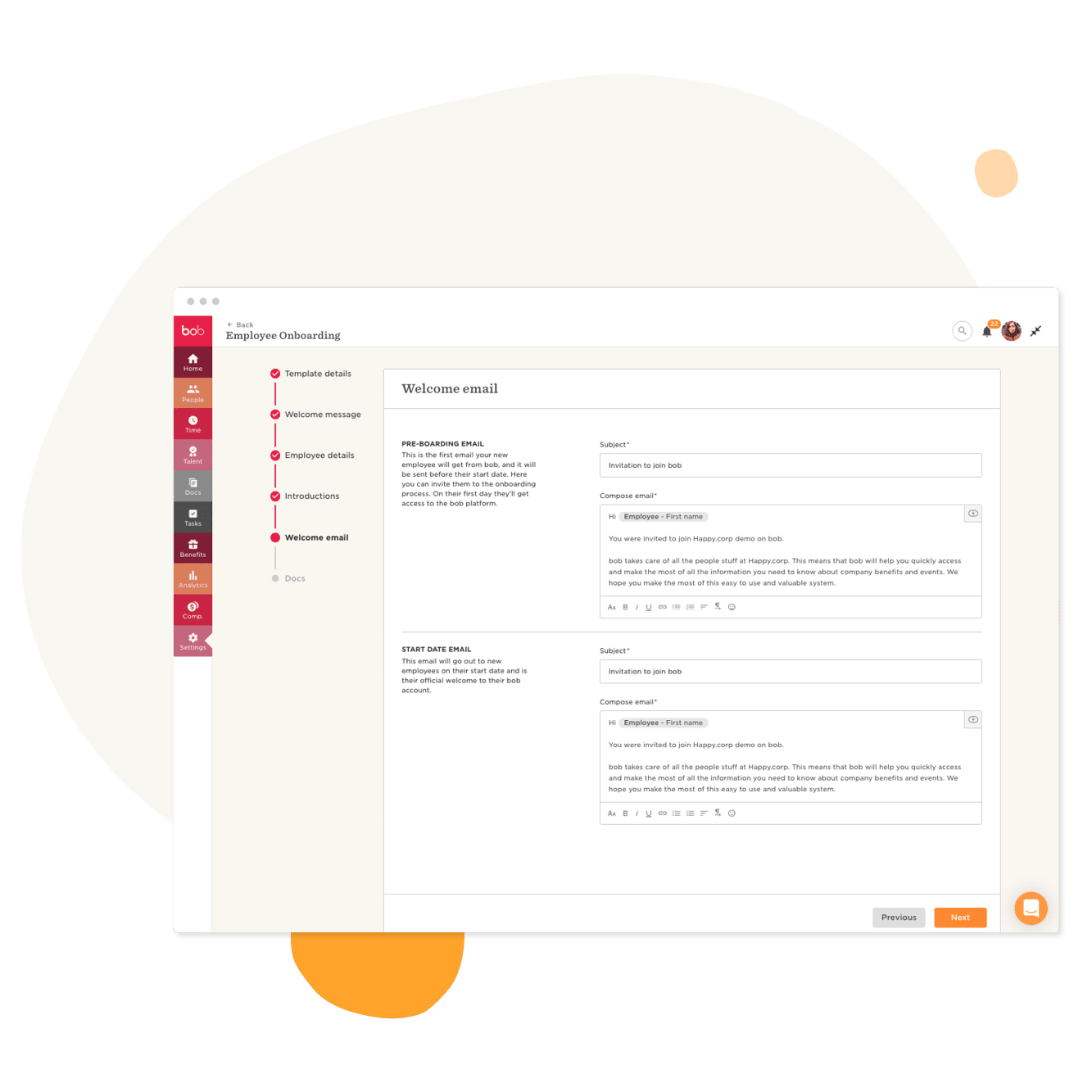
And, workflows are not only used for onboarding new hires. Workflows and tasks can also be created for other milestone processes such as training, performance reviews, and offboarding, which cover every detail, ensure efficiency and save valuable time.
Managing teams from Monday to Friday
Whether working remote, hybrid, or onsite, managers are responsible for ensuring that each team member knows what their tasks are and providing support when needed. Other daily managerial responsibilities include managing and approving attendance and time off.
1-on-1 meetings for empowering the manager-employee relationship
Offered as part of the Talent module, 1-on-1s allow the manager and employee to get to know each other on a personal level and designate a time to discuss current projects and provide feedback. To be most effective, 1-on-1s should happen regularly, whether weekly, bi-weekly, or monthly, and be a collaborative process where managers and employees can benefit. This continuous feedback model helps managers and their employees to stay in sync and maintain a healthy working relationship, keeping both parties happy and positively impacting retention rates.
Managers can schedule 1-on-1s directly within Bob, and both managers and employees can contribute to the agenda, prepare action items, and write notes. Bob also offers several templates for different types of meetings that can help guide the conversation. All 1-on-1s, present and past, are archived in Bob, enabling managers and employees to easily access them when needed.
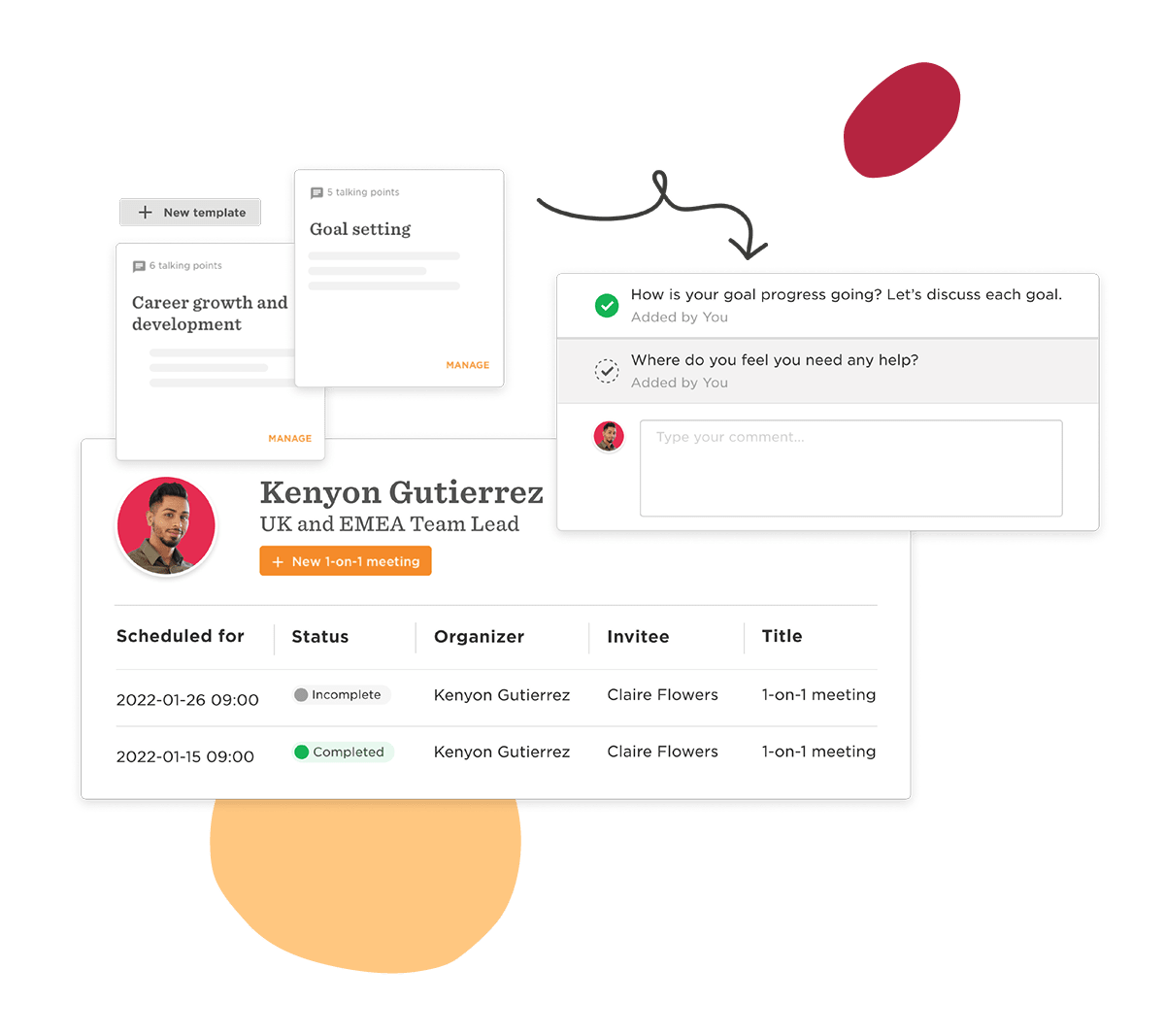
Managers can also schedule a 1-on-1 meeting as a task in a workflow for important employee milestones such as onboarding, performance reviews, goal-setting, and career growth and development. This way, the meetings are automatically set up ahead of time, saving managers time and effort.
Managing employees’ time and attendance and time off
Reviewing employees’ working hours and time off often falls under a manager’s responsibility. Managers need to ensure that their team members are staying productive while also not overdoing it by working too many hours, which can lead to burnout.
Bob makes time management completely seamless, offering two modules relating to time: Time Off for employees to request vacation, parental leave, wellness, or sick days, and Time and Attendance, where employees can log and submit their working hours.
All requests and approvals are done directly within Bob and are also supported on the mobile app for quick actions on the go. Both the employee and manager have access to a view of the employee’s time off, including their current balance and the number of days they’ve taken off in the current cycle. Managers can also view the information for all team members on one screen. Having this information readily available helps managers to make decisions regarding time off, such as checking that there aren’t too many people out at the same time.
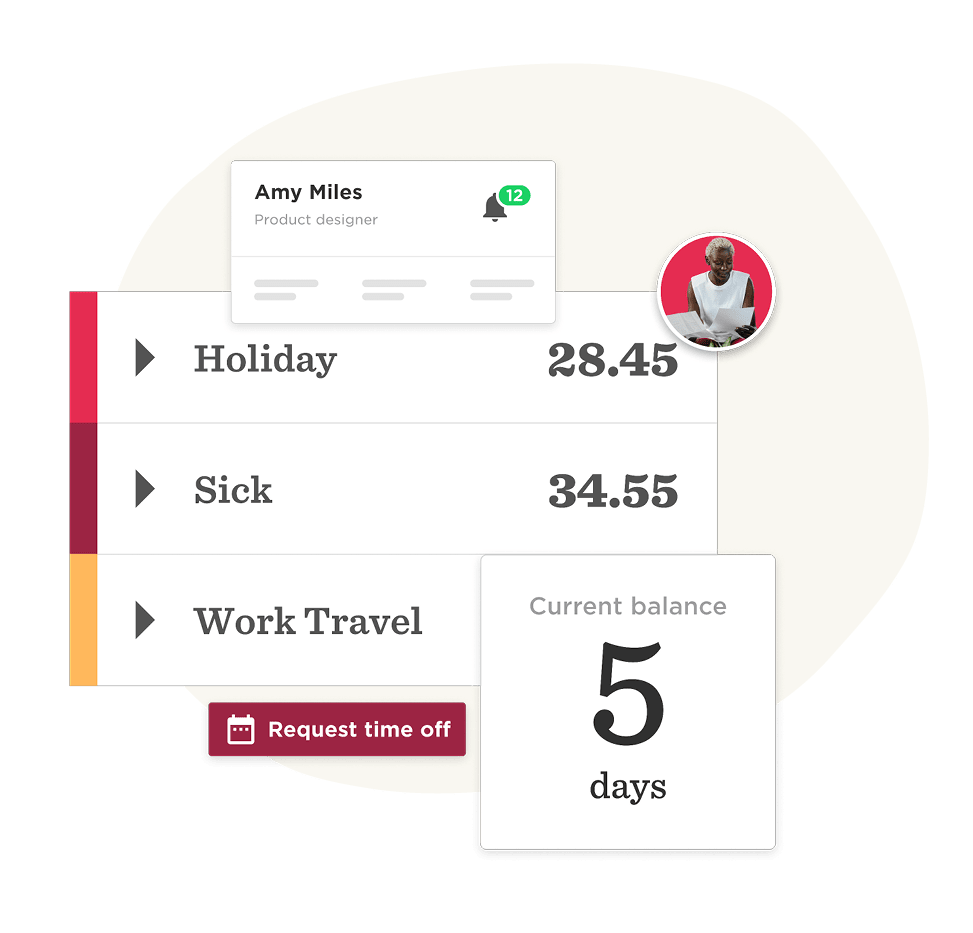
In organizations where managers are responsible for approving work hours, managers can view the timesheets of every member of their team on one screen, including the number of hours and number of days worked, making approving hours a breeze.
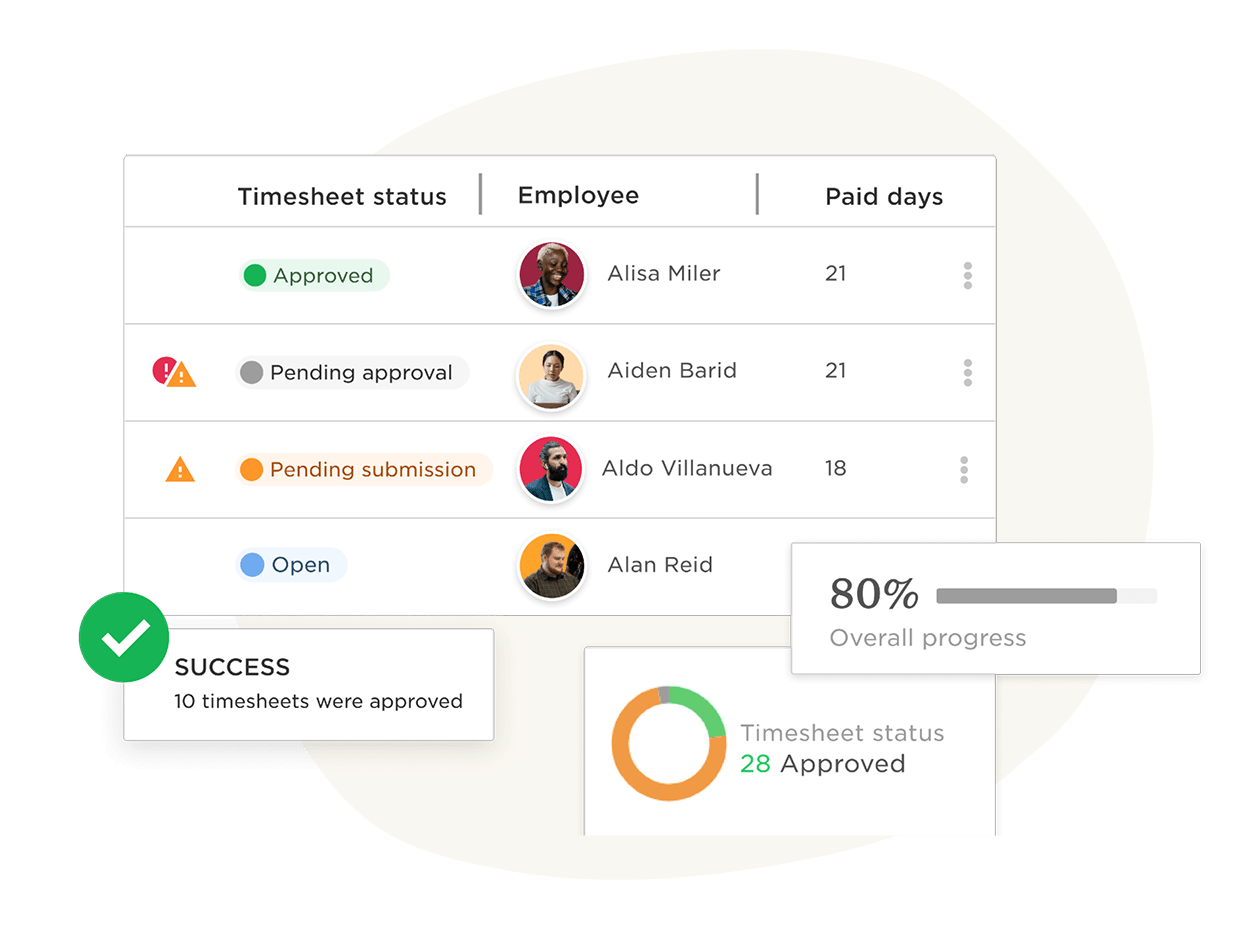
Performance management for growth and development
In addition to the day-to-day management of their team members, managers are also responsible for managing their performance which includes goal-setting and ensuring a seamless performance review process. Many companies conduct performance reviews once or twice a year and use this process to make decisions on employee growth and rewards.
Goal-setting for engaging and motivating employees
Numerous studies have shown that employees that receive clear goals are more motivated and perform better than those without assigned goals. By setting measurable and attainable goals, a manager can guide improvement in performance and increase motivation while also helping to strengthen the business.
Goals are included in Bob’s Talent module and cover personal goals, people’s goals, department goals, and company goals.
Bob’s Goals follow the OKR goal-setting framework, whereby managers define an overall goal or Objective and then break it down into Key Results, which are the specific steps required to achieve the desired outcome.
Managers can set, manage, and close goals for their direct reports directly within Bob and view their progress on one screen. This way, it’s easy to see at a glance where everyone on the team stands.
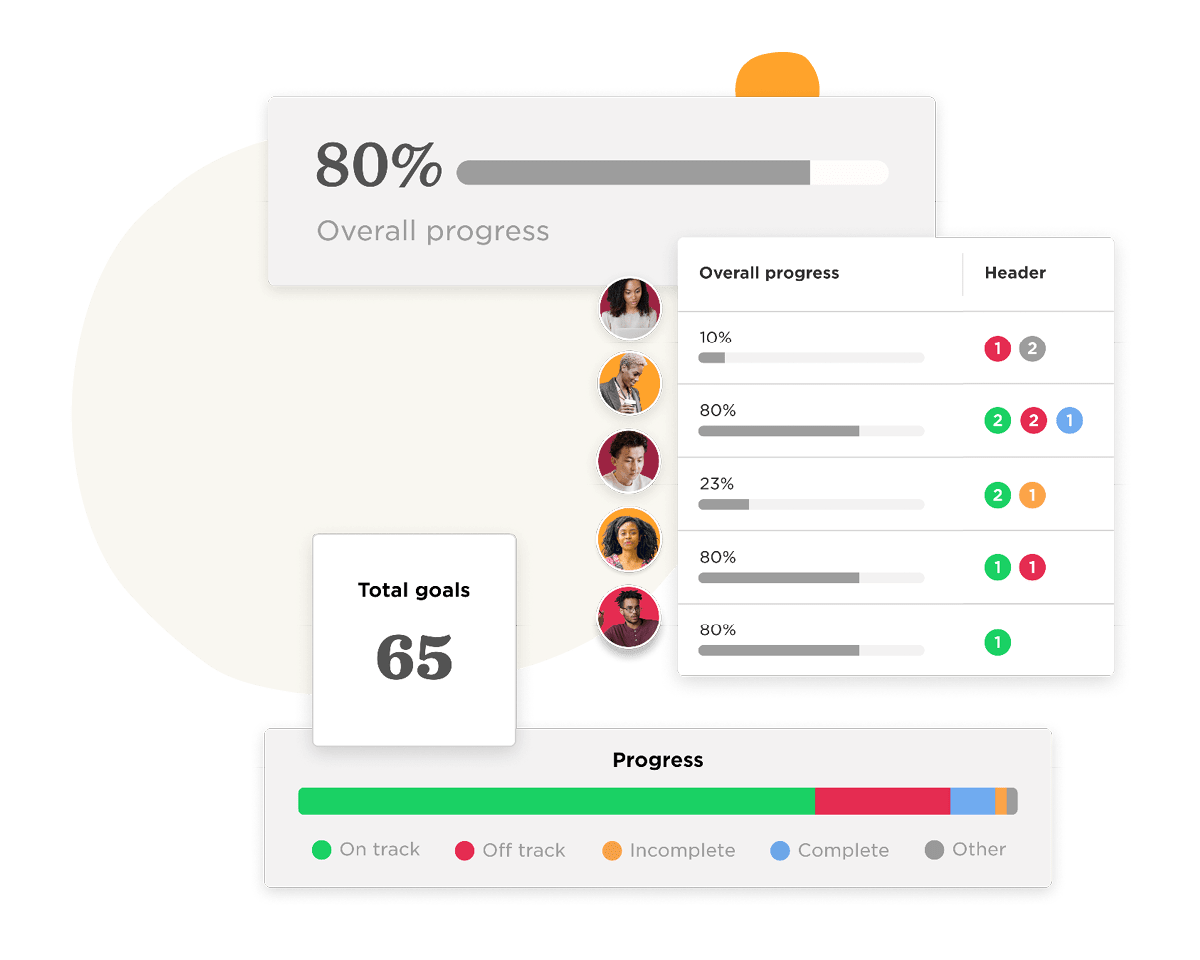
Employees can view their goals in Bob and adjust their progress by changing the numeric score assigned to a key result. They can also designate Goals as On Track (active) or Off Track (inactive), and both the manager and employee can leave comments relating to the goal to help them stay aligned.
Managers have access to their employees’ goals and statuses, so they know where they stand at any time, which is especially relevant when preparing for performance review discussions.
Managing performance review cycles
Bob makes performance reviews a fair and balanced process, with 360-degree performance reviews covering reviews from every angle: self, manager, peer, and direct reports.
The whole review process is easily managed within Bob and organized as a task list so that managers can assign tasks to additional stakeholders, such as for peer reviews, in a couple of clicks.
When filling out reviews for their direct reports, managers can view their previous performance reviews, personal goals, and 1-on-1s on the same screen, helping them to write fair and representative reviews. Plus, having everything located in one place means they don’t need to spend time looking through old emails and spreadsheets—all the information they need is easily accessible.
To keep the process moving and ensure that everything runs smoothly, all stakeholders receive automatic reminders from Bob to complete their feedback if they have not yet done so.
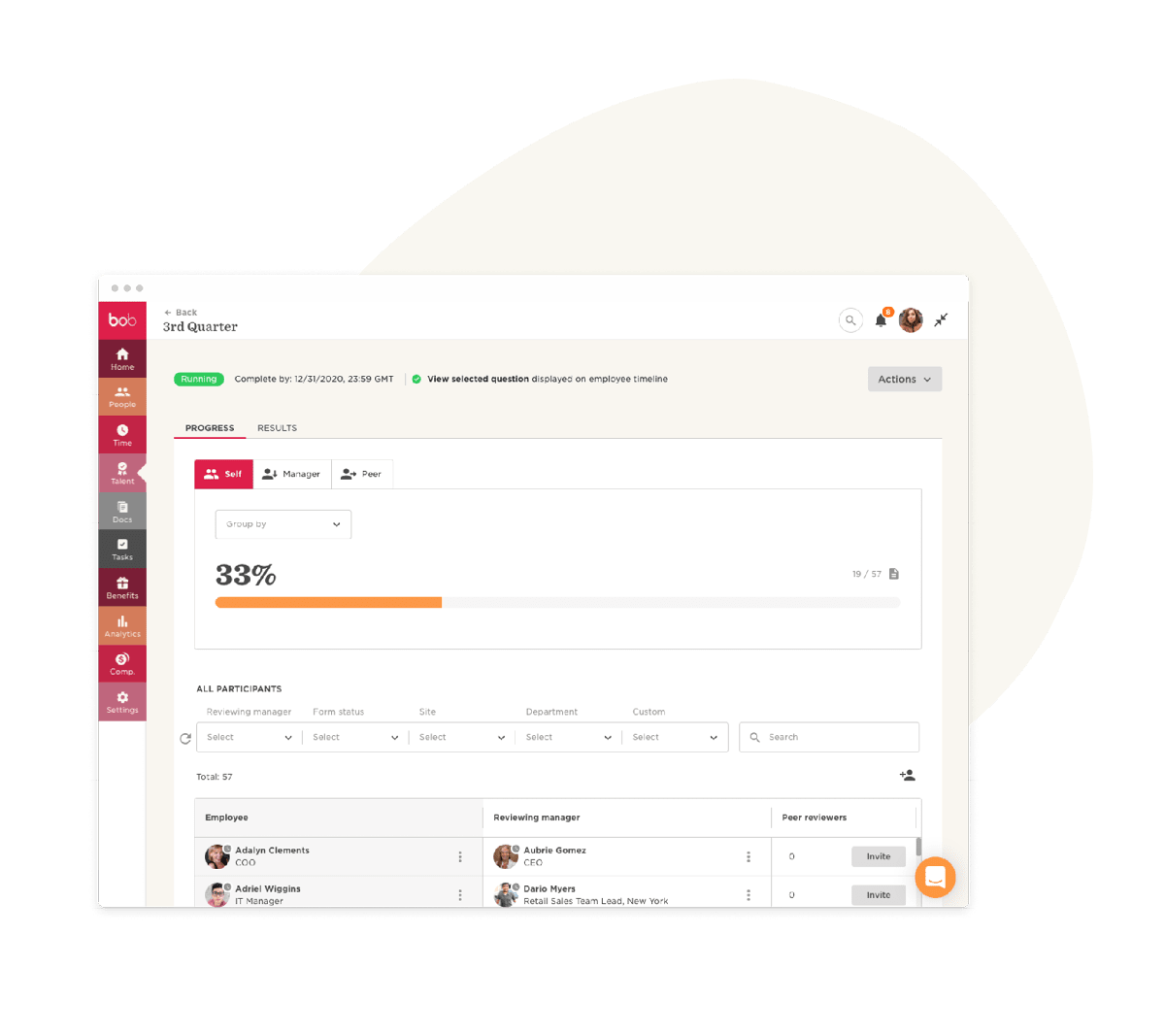
Performance mapping for a visual representation of employees
As part of the performance review process, managers and HR can use Bob’s performance mapping to ensure that the reviews are unbiased and that the manager’s evaluations are in line with other teams.
Bob’s performance mapping is modeled on the 9 box concept, whereby employees receive a score (low, moderate, or high) based on two specific attributes. However, unlike the traditional 9 box, in Bob, managers can take the scores from any two scaled questions from the performance review and use them to plot the employee on a grid. With each employee mapped on the same grid, managers can view how each employee fares for these specific attributes and identify outstanding employees.
Having the option to choose different attributes for measuring the team also enables managers to view their team in a holistic way, and see how team members fare across the board.
Performance mapping can also be used by HR on a company level, with the option to view employees by team, department, or site. This enables decision-makers to easily compare different groups from within the company, and identify future leaders.
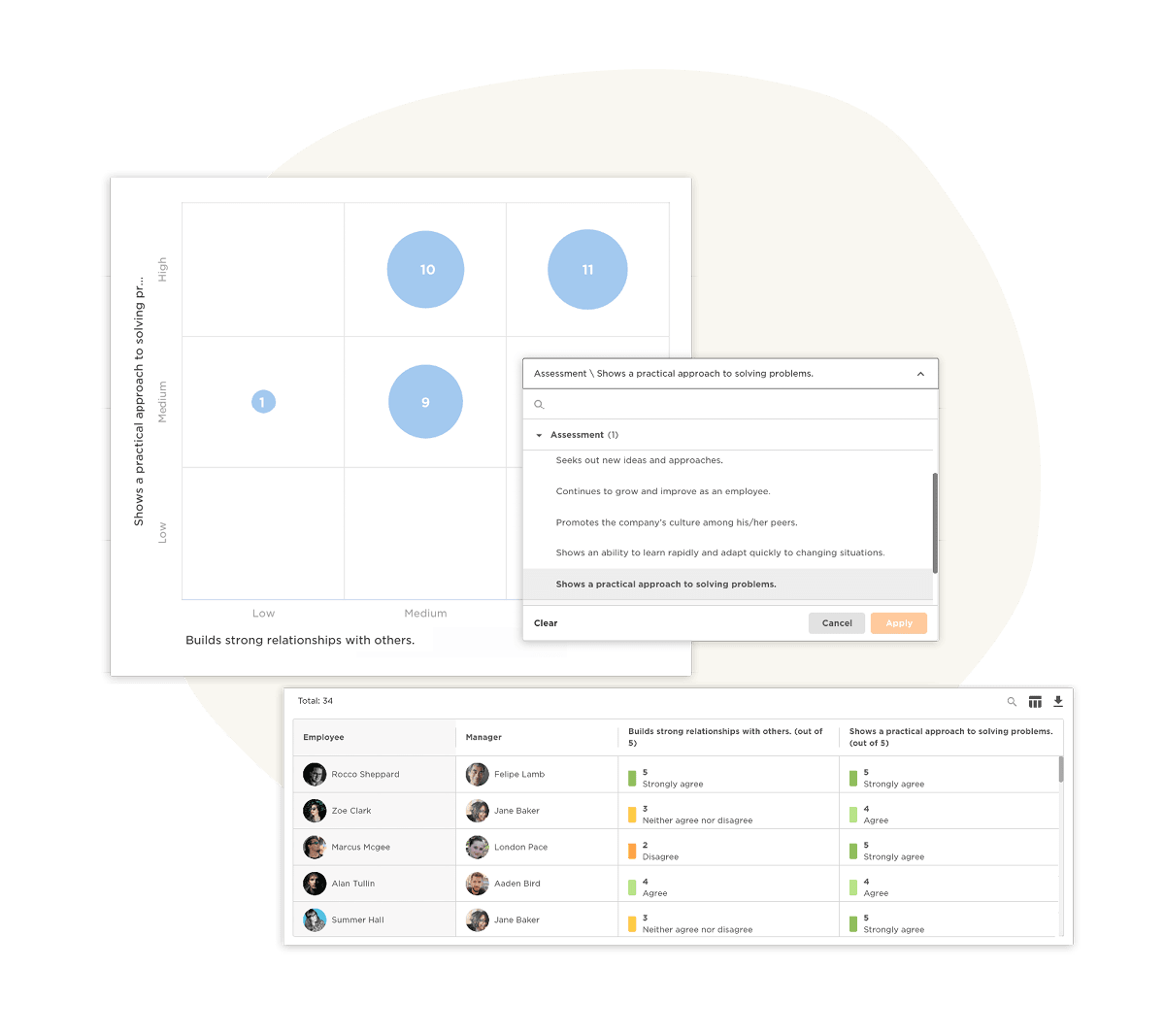
Managing compensation review cycles
Compensation reviews involve multiple stakeholders, such as team leads, senior managers, finance, and C-levels. Coordinating all these moving parts can pose a challenge.
Bob’s compensation management module eases the process, enabling all stakeholders to collaborate and approve salary increases directly within the platform.
Managers are often the starting point of the compensation review process, tasked with recommending employees for performance-based merit increases and bonuses. These can be made directly in Bob, saving time on email exchanges and complex spreadsheets and creating a transparent and seamless process.
Following the compensation review, all relevant salaries are automatically updated, and the increase will also be documented in Bob on the employee’s timeline, visible to the employee, their manager, and HR, and available for reference in a future review cycle.
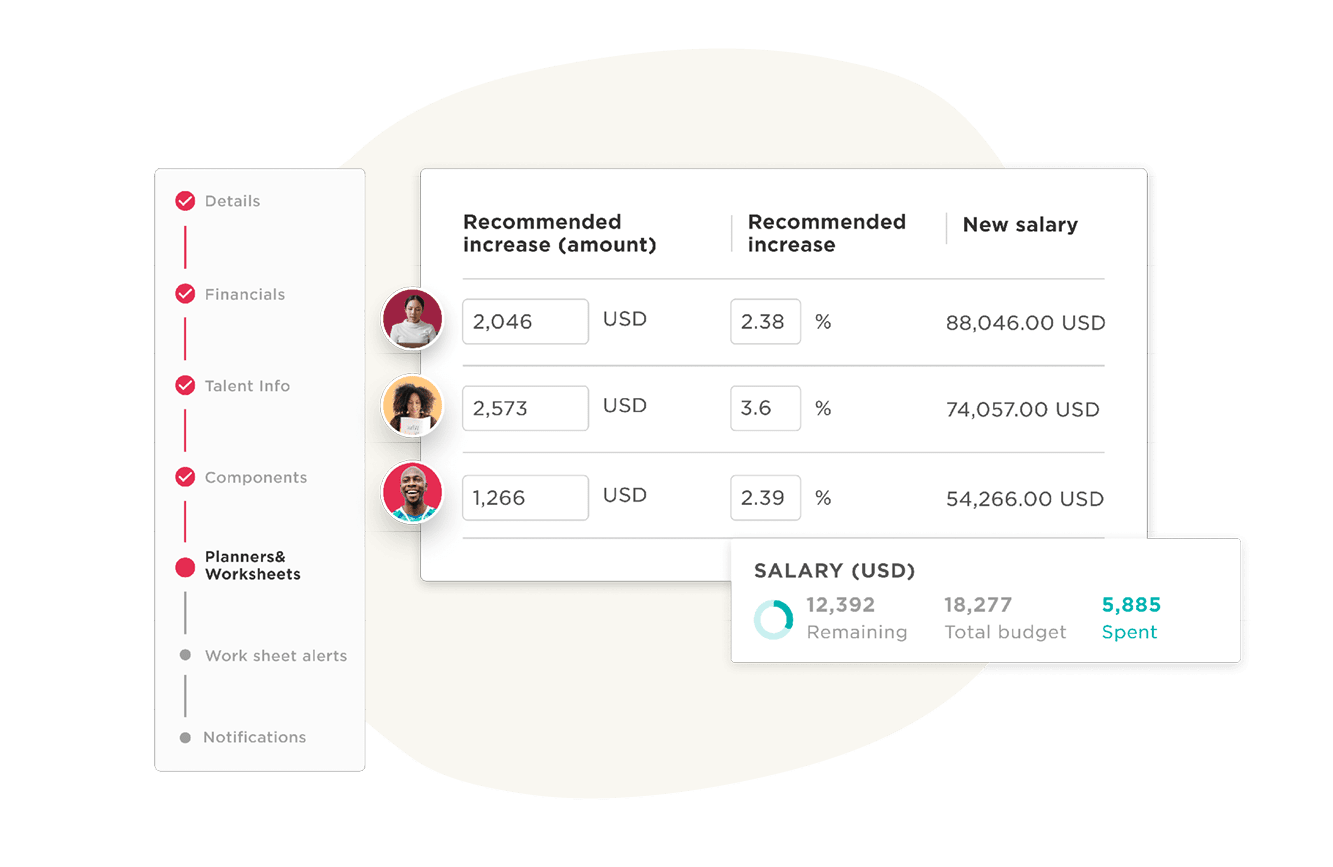
Using people data for making data-driven decisions
Having access to people data enables companies to understand more about their employees, identify issues and successes, and take action. This can relate to data on growth, diversity, the ratio of men to women, and average salary—to name just a few.
Bob’s People Analytics contains valuable data and insights
Bob’s People Analytics helps managers to gain an in-depth view of the employees on their teams and includes easy-to-use KPI dashboards on metrics such as headcount, turnover rate, attrition rate, tenure, salary changes, absenteeism, and career development. With this data at hand, managers can view information such as how their teams have grown over time, pay gaps, and the ratio of men to women, and take steps to rectify any inconsistencies or biases.
As the adage goes, “Knowledge is power,” and having access to people data empowers managers to manage their teams better with the tools in place to monitor trends and identify potential issues. And, with all people data conveniently located in one place and no complex spreadsheets to deal with, managers can spend less time on admin and more time focusing on their teams.

Recommended For Further Reading
Identifying employees at high risk of attrition
Another data-based tool available to managers is Bob’s Attrition Indicator, located in the employee profile. This tool gives managers an alternative view of their employees, helping them to identify attrition risk based on several well-known indicators for attrition—such as their age, number of children, time in current position, and seniority in the company. Bob gives a score for each attribute based on their risk status (low risk, some risk, or at risk), enabling managers to see if any of their team members are at risk for attrition and take the necessary steps to retain them.
Some indicators are based on an employee’s personal information and cannot be changed or fixed (such as their age or number of children), while others can be reviewed and rectified. So if, for example, the manager sees that an employee is at high risk of attrition and hasn’t received a salary increase in a long time, they can schedule a 1-on-1 meeting to discuss future opportunities or offer them incentives to stay with the company, such as a salary increase or promotion.

Empowered managers inspire their teams
Managers have an essential role within organizations—leading teams and ensuring that their people have everything they need to perform their jobs well. But to be successful, managers also need to be empowered. They need to be given authority, feel trusted, and have access to tools to help them manage their teams effectively.
An HR platform can provide managers with the tools to motivate their people from their very first day and throughout the employee lifecycle by driving performance, employee satisfaction, and retention. With less time spent on admin tasks and more time spent on managing, employees will be inspired and driven to succeed.
